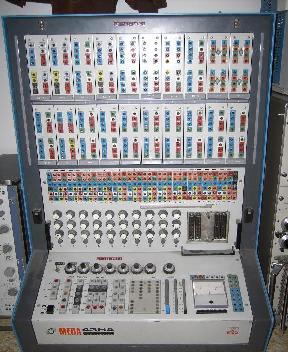| The MEDA 43 |

|
The MEDA 43 Analog/Hybrid Computer |
|
The MEDA 43 is one of the latest analog/hybrid computers built in the former czecholovakia. It is the last member of the MEDA series which found widespread use in many countries behind the iron curtain. The machine shown above dates back to the late 1970s, it seems quite reasonable to assume that the computer was built in 1977 - this should be kept in mind when comparing this system with is quite low packing density to older systems like the Telefunken RA 741 which was designed and build about 15 years earlier! The pictures in the following were taken from actually two systems which were donated by Mr. Manfred Kindler which I would like to thank for those two machines. They were taken care of by Prof. Hebestreit from the university of Leipzig where we picked them up on 11-JUL-2006. |
||
|
The picture above shows the complete system. It is a table top computer weighing about 100 kg fully expanded with modules and is more or less divided into three parts shown below (from left to right):
|
||
|
The picture below shows a removable patch panel for this system. This panel can be hooked to the front of the analog computer and connects to the 4 mm jacks of the modules by means of very fragile spring contacts. The front plates can be removed for easy accomodation of different computer configurations. |
||
|
The following three pictures show (from left to right)
|
||
|
The following pictures show top, bottom and front view of the TZP10 module which contains a summer/amplifier pair. |
||
|
The following pictures show top, bottom and front view of the TZP11 module which contains a pair of wideband amplifiers which are mainly used to setup integrators using the integrator capacitors shown above. |
||
|
The following pictures show top, bottom and front view of the TVZ10 module which contains a pair of analog memory cells. |
||
|
The following pictures show top, bottom and front view of the TDQ10 module which contains a multiplier/divider pair. |
||
|
The following pictures show top, detail and front view of the TDN10 module which contains a pair of non-linearities. |
||
|
The following pictures show top, bottom and front view of the TZK10 module which contains a comparator pair. |
||
| 11-JUL-2006, 26-JAN-2008, 28-DEC-2009 |